Eric Springer, Date Unknown
(Source: NASM)
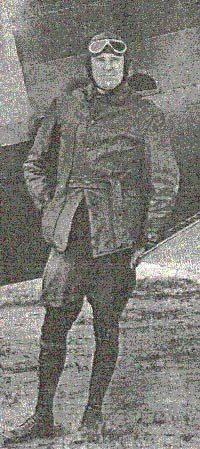 |
Eric Springer was born near Selmer, TN on January 23, 1892.
His family moved to Texas and he graduated from a local high
school in 1911. He was mechanically inclined. In the fall
of 1911 he entered Texas A&M, but stayed only one term due
to illness.
He opened a garage in Oklahoma, the venture did not work
out, and he moved to Los Angeles, CA to look for work, preferably
in auto mechanics. By 1914 he was working at the Ford assembly
plant in Los Angeles. During that time he met Glenn L. Martin
and learned about his flying school at Griffith Park. He
learned to fly, using his Ford earnings to pay for lessons.
He first flew a Martin-Curtiss type pusher, in which he is
pictured on
this page. He left Ford and joined Martin as an enthusiastic,
full-time instructor in 1915.
The Glenn L. Martin Company was formed in August 1917 to
provide a factory and flying field for WWI aircraft production
and testing. As a result, and since the money behind the
new company was based in Ohio, Martin, Springer and Laurence
Bell left for Cleveland where Donald Douglas soon joined
them.
They produced the WWI Martin Bomber
with two Liberty engines, which, for the time, was an outstanding
achievement. Springer did the test flying and made numerous
cross-country trips to demonstrate this large aircraft at
various military air fields. Unfortunately, the development
was too late to reach wartime production and, after the war,
aviation went into a slump.
Below, from the San Diego Aerospace Museum (SDAM), a photo of (L-R) Martin, Springer and Bell taken in 1917.
Donald Douglas, Eric Springer, Lawrence Bell, 1917, Cleveland, OH (Source: SDAM)
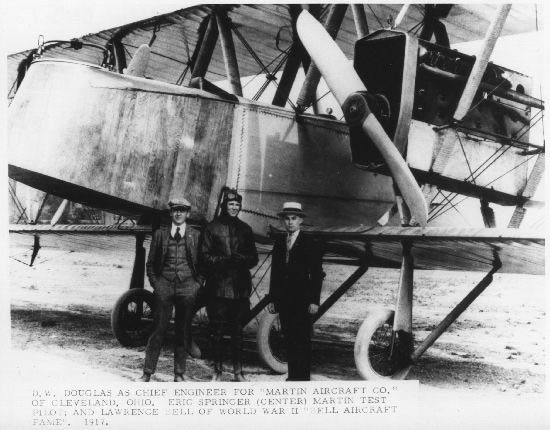 |
Below, a photo of their bomber including Martin.
Bell, Springer, Martin & Douglas in
front of the Martin Bomber, ca. 1918
(Source: NASM)
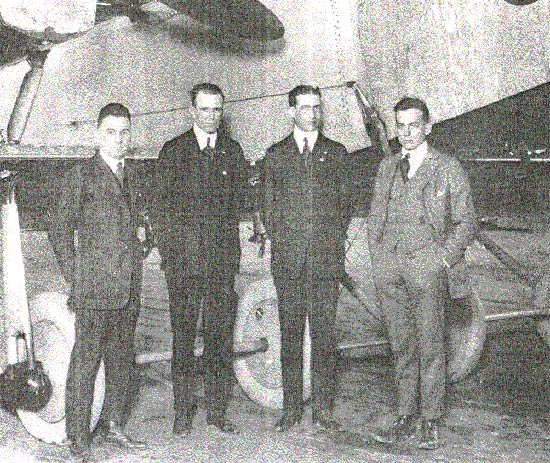 |
Below, courtesy of a site visitor, is a photograph of Springer (L), John Astor Jordan (US Air Mail Superintendent in charge of operations and airfields), Donald Douglas, Sr. (Martin chief engineer at the time) and our site visitor's great-grandfather J.T. Batts. They were seated in the prototype for the 1918 Martin twin-engine enclosed transport.
Eric Springer (L) et al, Ca. 1918, Martin Factory (Source: Site Visitor)
_etal.jpg) |
Below, courtesy of our site visitor, is a photograph of Springer (L) and our visitor's great-grandfather, J.T. Batts. The airplane is a Martin GMB, number 62950. This airplane was later modified to a Martin GMP and assigned to McCook Field as P106. The prototype exhibited in the photograph above is behind the port horizontal stabilizer of 62950. Comparing clothing, these two photos were taken on the same day.
Eric Springer (L) & J.T. Batts, Ca. 1918, Martin Factory (Source: Site Visitor)
_2.jpg) |
Douglas left the Martin company during the early summer of 1920
and moved back to Los Angeles. He enticed five other Martin
technicians, Springer among them, to join him. In rented
space behind a barber shop and on the second floor of a downtown
wood mill everyone, including Springer, began making parts
for a one-off aircraft for local wealthy sportsman David
R. Davis. Davis wanted to be the first person to be flown across
the U.S. and he commissioned Douglas to build the airplane.
When the component parts an subassemblies were finished they
were taken to the Goodyear Blimp Hangar at South Park where
the aircraft was assembled. Called the "Cloudster" it was
a large, well-designed biplane with excellent workmanship,
powered by a Liberty V-12 engine. Springer tested the ship
on February 24, 1921, and on June 27 he and Davis took off
from Riverside, CA with a full 650 gallons of gas, hoping
to land at Curtiss Field, Long Island, NY 30 hours and 2,500
miles away. Below, from SDAM, is a photograph of Springer standing in front of the "Cloudster." The top photo of Springer, from a news source in his NASM file, was cropped from this original image.
Eric Springer with the Douglas "Cloudster," Date Unknown (Ca. 1923?) (Source: SDAM)
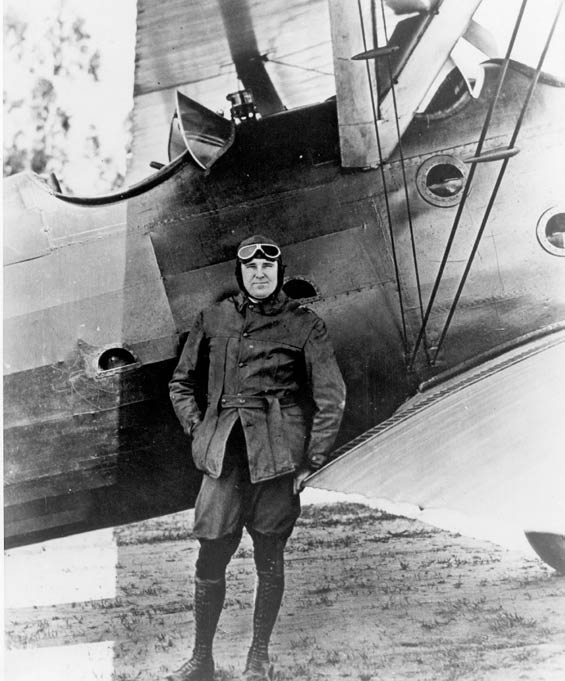 |
Alas, the timing gear stripped near El Paso, TX. The
engine was repaired and they flew back to California for
a new start. Unfortunately, there were delays getting airborne
again, and by the time they were ready, Oakley Kelly and John Macready made
their record east-to-west transcontinental flight in 1923.
I go into this detail to set up the fact that the Cloudster,
which our pilot Springer helped build and test, was a very
special airplane in that it was the first one to be able
to lift a load equivalent to its own empty weight. Douglas
used the design to build a Naval torpedo version of the Cloudster
on twin floats. The Navy bought over thirty of them. Then
came the World
Flight and the Douglas Cloudster
design was again modified. The Army ordered four of them
on floats for the World Flight.
Springer's Pilot Certificate ID, No. 403, 1927
(Source: NASM)
 |
We find Eric Springer at Tucson Wednesday, November 7, 1928. Based at Santa Monica, CA, Clover Field, he was flying de Havilland DH-1 NX7281. He carried Donald Douglas as his sole passenger. They were eastbound from Yuma, AZ to El Paso, TX. No purpose for their trip was given in the Register, but see the airplane's link for a conjecture.
Springer went on to an illustrious career with Douglas.
He remained a test pilot until 1930, then was appointed Supervisor
of Production Control until 1935. At that time he was made
Assistant Factory Superintendent until 1939. He became Assistant
Plant Manager of the El Segundo plant in July 1939. Later
he was Vice President and General Manager of that facility,
where he remained until his retirement in 1957.
One of his official duties for Douglas was probably to attend the compound anniversary described in the following postal cachet. Shared with us by site visitor Jeff Staines, the cachet commemorates the 200th anniversary of president George Washington's birth, as well as his inauguration on April 30, 1789.
Eric Springer, U.S. Airmail postal Cachet, April 30, 1932 (Source: Staines)
 |
At the time he assumed management at El Segundo, it had
about 800 employees and about 600,000 square feet of production
space. When he retired, it had grown to 5.5 million square
feet and over 20,000 employees.
Springer passed away on April 4, 1971 at age 79. He was
the test pilot of many types of new aircraft. In many job
roles, he became one of the stalwarts of management who helped
Douglas Aircraft attain world renown.
---o0o---
Dossier 2.1.150
THIS PAGE UPLOADED: 01/17/07 REVISED: 05/07/09, 06/26/11, 08/25/11, 11/21/16
|

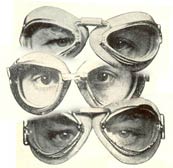



_etal.jpg)
_2.jpg)


